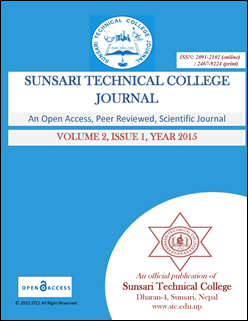Preparation and Quality Evaluation of Jamun (Syzygium cumini L) Wine
DOI:
https://doi.org/10.3126/stcj.v2i1.14792Keywords:
quality evaluation, jamun, Syzygium cumini L, wine preparationAbstract
The study aims to determine the effect of various strength of juice content (100%, 75%, 50% and 25%) on the chemical and sensory qualities of the wines. Sensory analysis showed that there was no significant difference among all the products with respect to colour but showed significant difference with other respect. The product prepared from 50% juice content got the highest mean score in sensory analysis. Changing pattern of pH, total sugar, TSS and acidity in all fermentations were similar but differed significantly with respect to their changing values. The average pH, Total soluble solids (TSS- ºBx), alcohol content (% m/v), acidity (% citric acid), total sugar (% dextrose) of the best product i.e juice content of 75% were found to be 3.53, 10, 6, 0.82, 6.12 respectively. Wine made from other formulations (juice content) were significantly different (at 5% level of significance) from the best formulation with respect to TSS, alcohol content, total sugar and pH but showed similarities with the product made from 100% juice content in respect of acidity. Fermentation mash containing 50% juice content, 50% water, 20ºBx TSS, and 3.4 pH was found to be optimum for wine preparation using wine yeast at ambient temperature. The optimized recipes were cost effective over other tested variations.
Sunsari Technical College Journal 2015, 2(1):17-22




